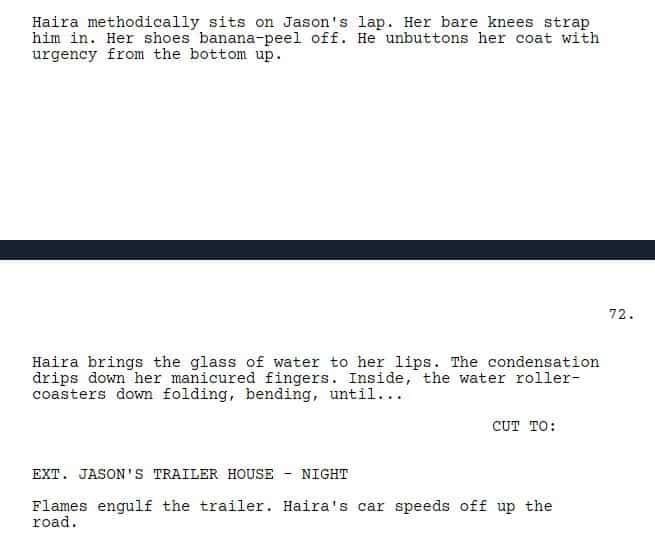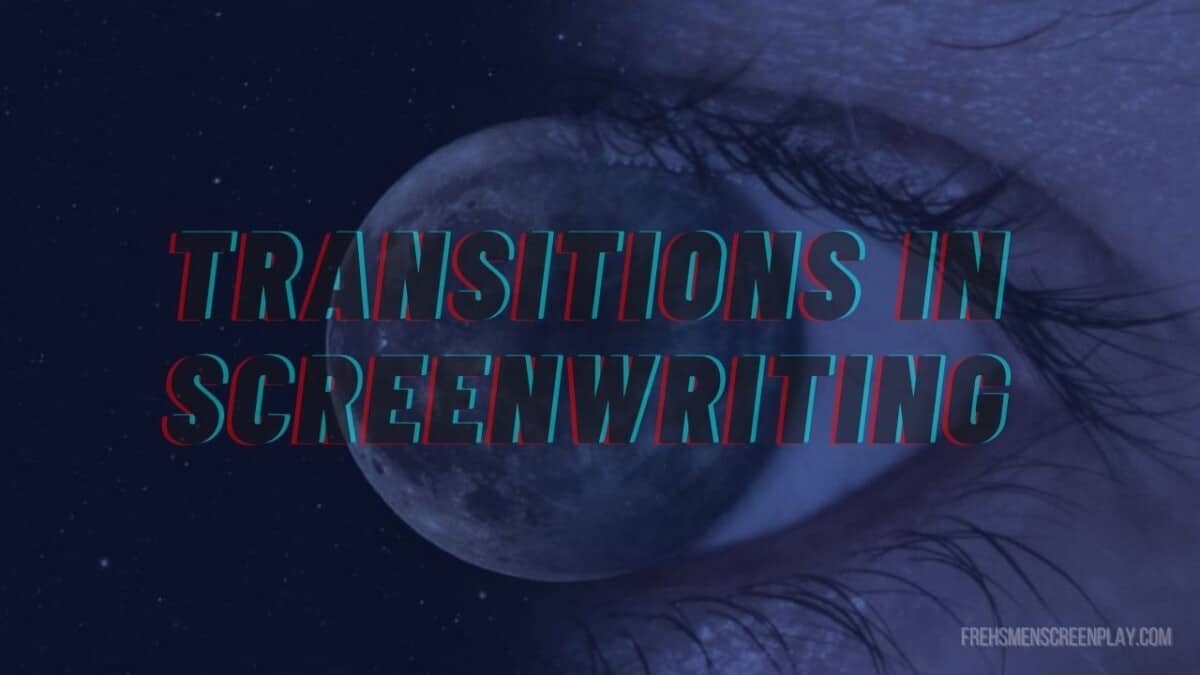Just like in a movie in screenplays, there are transitions.
In this post, we will cover everything you need to know about transitions in screenwriting, from what they are, how to use them, where to write them and when not to.
Let’s get into it.
What is a Transition in a Script?
What is a transition in screenwriting? A transition in screenwriting is a “cut,” indicating that a scene is over and another is beginning. Usually taking readers to a new location.
Examples:
What are All the Transitions in Screenwriting?
Below are a list of every transition in screenwriting from most popular to least. Also charted are their uses
| List of Transitions | Is it Still Used Today? | How it’s Used |
|---|---|---|
| CUT TO: | Still used. | Acts as a jarring quick cut to another scene. |
| BACK TO: | Still used. | After cutting to another scene/location. This is an indication that we are back in the previous scene/location. Called a cutaway. |
| FADE IN: | Still used. | At the beginning of most screenplays, this is used to indicate the story is beginning. |
| FADE OUT. | Still used. | At the end of the script after the last scene. this indicates that the screenplay is completely finished. |
| JUMP CUT TO: | Somewhat used. | This indicates that we are cutting from different spaces in time. Has been replaced with CUT TO: in most scripts. Normally called Jump cuts. |
| (PRE-LAP) | Rarely | A sound transition is used when the dilaogue of the scene starts before the next scene starts. |
| SMASH CUT TO: | Never. | When something extremely exciting or dramatic is happening and your jumping to something else of the same caliber. |
| DISSOLVE TO: | Never. | Acts as a fade from one scene to the next. |
| WIPE TO: | Never. | Like Star Wars this transition wipes across the screen. In modern times it can be known as the invisible cut. |
| MATCH CUT TO: | Never. | Whenever you’re leaving an image from a scene that looks almost the same as the previous image you are matching them together. |
| TIME CUT TO: | Never. | Used in montages when the same location is used but in a different time period. |
Now that you know all the transitions and the purposes. Let’s see a visual example of how they are used in the final film.
How do you Write a Transition in a Screenplay?
How do you write a transition in a screenplay? You write a transition in a script by writing it in all caps on the right side of the page on its own line, followed by a semicolon.
Example:
INT. HOUSE - DAY
John waits, bag in hand. He peers out his bedroom window. A car rolls up slowly in the driveway. His eyes ignite with excitement. Then the car turns around. His smile fades.
CUT TO:
EXT. HIGHWAY - DAY
Roger swerves into oncoming traffic.
Unless it’s FADE IN: this should be in the top left, and the reader sees first when reading a screenplay.
Example:
FADE IN:
INT. HOUSE - DAY
FADE OUT. also should be written on the bottom right but it ends in a period not semicolon like the other transitions.
Example:
INT. HOUSE - DAY
John waits, bag in hand. He peers out his bedroom window. A car rolls up slowly in the driveway. His eyes ignite with excitement. Then the car turns around. His smile fades.
FADE OUT.
Example:
John's Father (PRE-LAP)
I will meet you at the station just wait for me.
INT. HOUSE - DAY
John waits, bag in hand. He peers out his bedroom window. A car rolls up slowly in the driveway. His eyes ignite with excitement. Then the car turns around. His smile fades.
Are Transitions Necessary in a Screenplay?
Why?
A couple reasons
1.) Transitions in screenwriting are Implied
Transitions are implied now. When we see a new scene heading in a screenplay, we assume a cut to a new scene. And the director is responsible for that transition and has the final say on what goes there, not the writer.
2.) Its old school
Transitions are a very old-school way of cutting from one scene to another, back in the 1950s, when screenwriting was relatively new. Screenwriters used them all the time to inform the director and editor. Screenwriters had more power over the final image.
Should I use Transitions in Screenwriting?
Should you use transition’s in screenwriting? You should not use transitions in screenwriting. They are an old way of writing that has been fazed out over the last decade.
But if you do they should be used sparingly. More on that below.
Why?
A couple reasons
1.) Its perceived as amateurish writing
When a reader sees transitions in a screenplay it is seen as the mark of an armature writer. Most producers stop reading after a couple of transitions seen in a row. It shows your trying to control the overall image on the screen. Which means you less focused on the story.
2.) It slows down the pace
There is an inherent pace, flow to reading any story. A transition stops that flow. It’s jarring and throws the reader off. Because then, on top of visualizing the story, they have to visualize the transition as well. Its overload.
When should you use transitions in Screenplays
Yes, like with any screenwriting tool there is a time and a place for using a transition in your script.
I personally use CUT TO: it, in my opinion, is the most versatile transition, and it’s still expectable to be used today. It not only can be used for jump cuts but also represents jumps in time and cutaways. But…
I only use it to enhance the story.
here is the scene.

Conclusion
I hope you enjoyed my ultimate guide to screenwriting transitions
If you remember anything from this post remember:
- Cut to is the most important transition.
- Most transitions are written on the right-hand side of a script.
- Use them only to enhance the story not to tell the story.
Now its time to hear from you:
Did I miss anything?
Which tip from today’s guide are you going use?
What transitions have you seen in screenwriting?
Either way, let me know in the comments below.
Happy writing.

